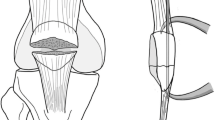Abstract
Tension-band wiring is commonly used to treat transverse patella fractures. The most common configuration has parallel Kirschner (K) wires and a stainless steel wire loop placed in a vertically oriented figure of eight. Early mobilisation is important but can cause detrimental displacement at the fracture site. A wooden model of a transversely fractured patella was used to compare different fixation constructs. The fracture was fixed using two K wires and a stainless steel wire loop. One or two wire twists were used, placed either arbitrarily or at corners of the loop. The loop was oriented either vertically or horizontally. Interfragmentary compression at the point of wire breakage and permanent displacement on cyclic loading was measured for each construct. Placement of the figure of eight in a horizontal orientation with two wire twists at the corner improved interfragmentary compression by 63% (p<0.05, Tukey post hoc test). On cyclic loading, all constructs with vertical figure of eight but none with a horizontal construct failed (p=0.01; Fisher’s exact test). Permanent fracture displacement after cyclic loading was 67% lower with horizontal figure of eight constructs (p<0.05; t test). Placing wire twists at the corner and a horizontal placement of figure of eight improves stability of the construct.
Résumé
Les cerclages métalliques sont utilisés de façon habituelle dans les fractures transversales de la rotule. La technique la plus courante est l’utilisation de deux broches et d’un cerclage en 8, placé de façon verticale. La mobilisation précoce est importante mais peut entraîner un déplacement secondaire. Un modèle en bois de rotule avec fracture transversale a été utilisé pour comparer différents modes de reconstruction. La fracture a été fixée par deux broches et un fil métallique. Un ou deux laçages par fil ont été utilisés, le laçage se faisant soit horizontalement, soit verticalement. La compression inter fragmentaire a été examinée au niveau du foyer de fracture et les ruptures de matériel évaluées après mise en charge et mobilisation du modèle. L’utilisation, comme sur la figure 8 d’un laçage horizontal avec deux broches tendues au niveau de chaque coin améliore la compression inter fragmentaire de 63% (p<0.05, Tukey post hoc Test). En charge, avec mobilisation, tous les montages avec cerclage vertical ont montré une faillite alors que tous les montages avec cerclage horizontal ont été satisfaisants (p=0.01 test de Fischer). Le déplacement secondaire après mise en charge et mobilisation cyclique avec un montage horizontal est de 67% inférieur (p<0.05). Nous pouvons donc conclure que, mettre deux broches tordues è chaque coin rotulien avec un montage horizontal, comme indiqué dans la figure 8, améliore la stabilité de l’ostéosynthèse.


Similar content being viewed by others
References
Benjamin J, Bried J, Dohm M, McMurtry M (1987) Biomechanical evaluation of various forms of fixation of patella. J Orthop Trauma 1(3):219–222
Carpenter JE, Kasman RA, Patel N et al (1997) Biomechanical evaluation of current patella fracture fixation techniques. J Orthop Trauma 11(5):351–356
Chen A, Hou C, Bao J et al (1998) Comparison of biodegradable and metallic tension-band fixation for patella fractures: 38 patients followed for 2 years. Acta Orthop Scand 69(1):39–42
Patel VR, Parks BG, Wang Y et al (2000) Fixation of patella fractures with braided polyester suture: a biomechanical study. Injury 31(1):1–6
Lotke PA, Ecker ML (1981) Transverse fractures of the patella. Clin Orthop 158:180–184
Muller ME, Algöwer M, Schneider R et al (1990) Manual of internal fixation, 3rd edn. Springer, Berlin Heidelberg New York
Schauwecker R (1974) The Practice of Osteosynthesis. Georg Thieme, Stuttgart
Smith ST, Cramer KE, Karges DE, Watson JT, Moed BR (1997) Early complications in the operative treatment of patella fractures. J Orthop Trauma 11(3):183–187
Weber MJ, Janecki CJ, Mcleod P et al (1980) Efficacy of various forms of fixation of transverse fractures of the patella. J Bone Joint Surg Am 62(2):215–220
Author information
Authors and Affiliations
Corresponding author
Rights and permissions
About this article
Cite this article
John, J., Wagner, W.W. & Kuiper, J.H. Tension-band wiring of transverse fractures of patella. The effect of site of wire twists and orientation of stainless steel wire loop: a biomechanical investigation. International Orthopaedics (SICO 31, 703–707 (2007). https://doi.org/10.1007/s00264-006-0238-0
Received:
Accepted:
Published:
Issue Date:
DOI: https://doi.org/10.1007/s00264-006-0238-0




